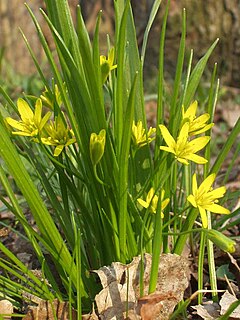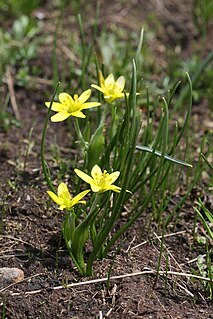
Gagea is a large genus of spring flowers in the lily family. It is found primarily in Eurasia with a few species extending into North Africa and one species in North America.

Tulipa turkestanica, the Turkestan tulip, is a species of tulip native to central Asia. It was first described by Eduard August von Regel in 1873 as a variety of T. sylvestris, then elevated to full species status two years later.

Gagea minima, known as the least gagea, is a Eurasian species of plants in the lily family.
Ivan Ivanovich Zarubin was a Soviet specialist of Iranian languages, particularly Pamir languages.
Allium kurssanovii is a species of wild onion native to Central Asia. It grows on cliff faces and other sun-lit locations at elevations of 2200–2700 m.
Allium platyspathum is an Asian species of wild onion. It has been reported from Xinjiang, Afghanistan, Kazakhstan, Kyrgyzstan, Mongolia, Altay Krai, Tajikistan, Uzbekistan, and Pakistan. It grows in damp locations at elevations of 1900–3700 m.
Allium schoenoprasoides is an Asian species of wild onion native to Xinjiang, Kazakhstan, Kyrgyzstan and Tajikistan. It can be found at elevations of 2700–3000 m.
Allium winklerianum is an Asian species of onion native to Xinjiang, Afghanistan, Tajikistan, Uzbekistan, Kyrgyzstan, and Tajikistan. It is also cultivated as an ornamental elsewhere because of the pretty flowers and also because of the strong lilac scent to the blooms.
Allium filidens is a species of onion found at high elevations of central and south-central Asia. It is a bulb-forming perennial up to 45 cm tall, forming a hemispherical umbel of flowers; tepals white or pink with a purple midvein.
Allium griffithianum is a species of flowering plant in the Amaryllidaceae family. It is an onion found in the high mountains of Pakistan, Afghanistan, Kyrgyzstan, Uzbekistan and Tajikistan. It is a perennial herb up to 40 cm tall, with a hemispherical umbel of flowers, white or light pink or pale purple.

Gagea alberti is an Asian species of plants in the lily family, native to Kazakhstan, Kyrgyzstan and Xinjiang Province of western China.
Gagea altaica is an Asian species of plants in the lily family, native to Kazakhstan, Siberia, and Xinjiang Province of western China.
Gagea divaricata is an Asian species of plants in the lily family, native to Kazakhstan, Kyrgyzstan, Tajikistan, Uzbekistan, and Xinjiang Province of western China.
Gagea fedtschenkoana is an Asian species of plants in the lily family, native to Russia, China (Xinjiang), Kazakhstan, and Mongolia.
Gagea filiformis is an Asian species of plants in the lily family, native to Russia, China (Xinjiang), Kazakhstan, Kyrgyzstan, Tajikistan, Uzbekistan, Afghanistan, Pakistan, and Mongolia.
Gagea granulosa is a Eurasian species of plants in the lily family. It is native to Russia, Kazakhstan, China (Xinjiang), and Mongolia.
Gagea jaeschkei is an Asian species of plants in the lily family. It is native to Kazakhstan, Xinjiang, Tajikistan, Uzbekistan, Afghanistan, Pakistan, and northern India.
Gagea olgae is an Asian species of plants in the lily family. It is native to Iran, Pakistan, Afghanistan, Kyrgyzstan, Tajikistan, Uzbekistan, Kazakhstan, and Xinjiang.
Gagea kunawurensis is an Asian species of plants in the lily family. It is native to Central Asia, Xinjiang, Afghanistan, Iran, Pakistan, Western Himalayas, and South Caucasus.
Gagea tenera is an Asian species of flowering plants in the lily family. It is native to Xinjiang, Central Asia, the Western Himalayas, Iran, Turkey, and South Caucasus.



